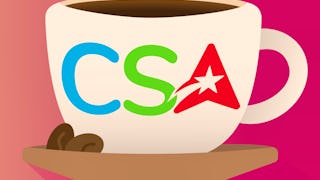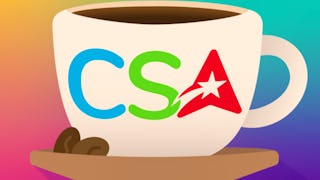Learn to program using Class design and 1-D Arrays in Java, and prepare to teach others using the free, online interactive CS Awesome textbook. In this course for teachers we'll guide you both in learning Java concepts and skills but also in how to effectively teach those to your students.

Ends tomorrow. Heat up your career with 40% off courses from Adobe, IBM, and more. Save now.


Learn to Teach Java: Writing Classes and Arrays
This course is part of Learn to Teach Java Specialization

Instructor: Beth Simon
2,570 already enrolled
Included with 
(14 reviews)
Skills you'll gain
Details to know

Add to your LinkedIn profile
15 assignments
See how employees at top companies are mastering in-demand skills

Build your subject-matter expertise
- Learn new concepts from industry experts
- Gain a foundational understanding of a subject or tool
- Develop job-relevant skills with hands-on projects
- Earn a shareable career certificate

There are 5 modules in this course
Meet Dr. Simon and fellow learners in this class! Find out what you’ll be doing and learning.
What's included
2 videos2 readings1 discussion prompt
We've been using objects of classes created by others -- now it's our turn! Using CS Awesome, we'll learn to design and create classes by encapsulating data and methods.
What's included
14 videos4 assignments
This week we'll go deeper and engage with some resources to support your teaching. You'll learn how these concepts are commonly assessed, but focus a LOT on how class creation can be assessed -- especially on the APCS A free response questions. Finally, you can check your own Unit 5 Java and Java Teacher mastery on our end of Unit 5 quizzes.
What's included
14 videos5 assignments
Arrays extend the power of iteration to allow us to repeat instructions on (potentially) large sets of data. Want to store and calculate grades for an entire class of students? Want to find the minimum or maximum temperature in a file of historical temperature readings? Use arrays! Using CS Awesome, we'll learn to create and iterate over 1-dimensional arrays and really start to ramp up our problem solving skills.
What's included
12 videos1 reading4 assignments
This week we'll go deeper and engage with some resources to support your teaching. You'll explore some questions to use in classroom analysis discussions (Peer Instruction) and and learn how these concepts are commonly assessed. Again, we'll look at the kinds of free response questions one can ask about arrays! Finally, you can check your own Unit 6 Java and Java Teacher mastery on our end of Unit 6 quizzes.
What's included
6 videos1 reading2 assignments1 app item
Earn a career certificate
Add this credential to your LinkedIn profile, resume, or CV. Share it on social media and in your performance review.
Instructor

Offered by
Explore more from Education
 Status: Free Trial
Status: Free Trial
University of California San Diego
 Status: Free Trial
Status: Free Trial
University of California San Diego
 Status: Free Trial
Status: Free Trial
University of California San Diego
 Status: Free Trial
Status: Free Trial
University of California San Diego
Why people choose Coursera for their career





Open new doors with Coursera Plus
Unlimited access to 10,000+ world-class courses, hands-on projects, and job-ready certificate programs - all included in your subscription
Advance your career with an online degree
Earn a degree from world-class universities - 100% online
Join over 3,400 global companies that choose Coursera for Business
Upskill your employees to excel in the digital economy
Frequently asked questions
If you complete all courses in the Learn to Teach Java Specialization, then you can earn 4-graduate units from UC San Diego. Find out more on the the specialization FAQ.
Access to lectures and assignments depends on your type of enrollment. If you take a course in audit mode, you will be able to see most course materials for free. To access graded assignments and to earn a Certificate, you will need to purchase the Certificate experience, during or after your audit. If you don't see the audit option:
The course may not offer an audit option. You can try a Free Trial instead, or apply for Financial Aid.
The course may offer 'Full Course, No Certificate' instead. This option lets you see all course materials, submit required assessments, and get a final grade. This also means that you will not be able to purchase a Certificate experience.
When you enroll in the course, you get access to all of the courses in the Specialization, and you earn a certificate when you complete the work. Your electronic Certificate will be added to your Accomplishments page - from there, you can print your Certificate or add it to your LinkedIn profile. If you only want to read and view the course content, you can audit the course for free.
More questions
Financial aid available,

